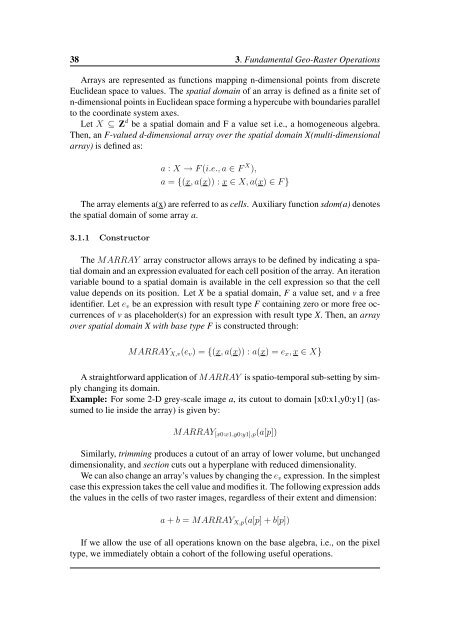Applying OLAP Pre-Aggregation Techniques to ... - Jacobs University
Applying OLAP Pre-Aggregation Techniques to ... - Jacobs University
Applying OLAP Pre-Aggregation Techniques to ... - Jacobs University
You also want an ePaper? Increase the reach of your titles
YUMPU automatically turns print PDFs into web optimized ePapers that Google loves.
38 3. Fundamental Geo-Raster Operations<br />
Arrays are represented as functions mapping n-dimensional points from discrete<br />
Euclidean space <strong>to</strong> values. The spatial domain of an array is defined as a finite set of<br />
n-dimensional points in Euclidean space forming a hypercube with boundaries parallel<br />
<strong>to</strong> the coordinate system axes.<br />
Let X ⊆ Z d be a spatial domain and F a value set i.e., a homogeneous algebra.<br />
Then, an F-valued d-dimensional array over the spatial domain X(multi-dimensional<br />
array) is defined as:<br />
a : X → F (i.e., a ∈ F X ),<br />
a = {(x, a(x)) : x ∈ X, a(x) ∈ F }<br />
The array elements a(x) are referred <strong>to</strong> as cells. Auxiliary function sdom(a) denotes<br />
the spatial domain of some array a.<br />
3.1.1 Construc<strong>to</strong>r<br />
The MARRAY array construc<strong>to</strong>r allows arrays <strong>to</strong> be defined by indicating a spatial<br />
domain and an expression evaluated for each cell position of the array. An iteration<br />
variable bound <strong>to</strong> a spatial domain is available in the cell expression so that the cell<br />
value depends on its position. Let X be a spatial domain, F a value set, and v a free<br />
identifier. Let e v be an expression with result type F containing zero or more free occurrences<br />
of v as placeholder(s) for an expression with result type X. Then, an array<br />
over spatial domain X with base type F is constructed through:<br />
MARRAY X,v (e v ) = {(x, a(x)) : a(x) = e x , x ∈ X}<br />
A straightforward application of MARRAY is spatio-temporal sub-setting by simply<br />
changing its domain.<br />
Example: For some 2-D grey-scale image a, its cu<strong>to</strong>ut <strong>to</strong> domain [x0:x1,y0:y1] (assumed<br />
<strong>to</strong> lie inside the array) is given by:<br />
MARRAY [x0:x1,y0:y1],p (a[p])<br />
Similarly, trimming produces a cu<strong>to</strong>ut of an array of lower volume, but unchanged<br />
dimensionality, and section cuts out a hyperplane with reduced dimensionality.<br />
We can also change an array’s values by changing the e v expression. In the simplest<br />
case this expression takes the cell value and modifies it. The following expression adds<br />
the values in the cells of two raster images, regardless of their extent and dimension:<br />
a + b = MARRAY X,p (a[p] + b[p])<br />
If we allow the use of all operations known on the base algebra, i.e., on the pixel<br />
type, we immediately obtain a cohort of the following useful operations.
















